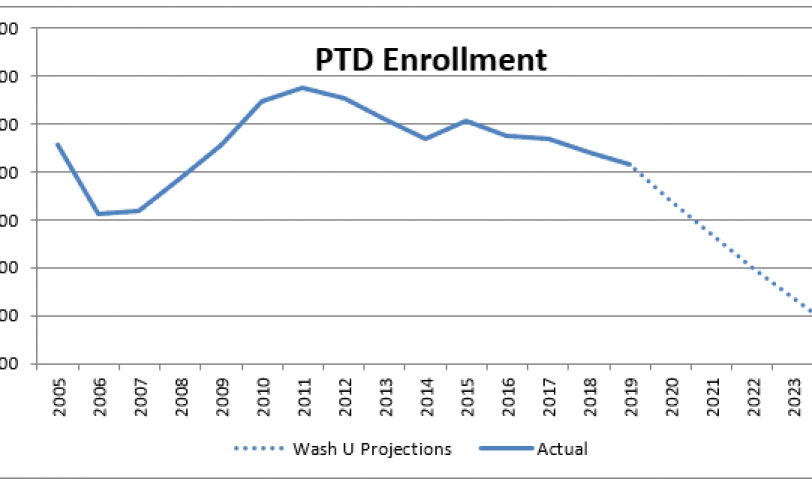Uh Oh: Are Medicaid Expansion Savings Built on False Promises?

Supporters of expanding Medicaid in Missouri argue that expansion will save the state money. Washington University and the Missouri Budget Project developed models that project significant savings under Medicaid expansion. A big part of the “savings” the models achieve comes from assuming a more than 20% reduction in the number of disabled enrollees (see graph above). But since Medicaid expansion has no impact on the eligibility criteria for individuals who are considered permanently and totally disabled (PTD), how could this realistically occur? It turns out the state’s Medicaid agency would have to adopt enrollment policies that ignore federal law to accomplish this. And by 2024, this error would blow a nearly billion-dollar hole in the state savings from the model’s projections.
People with disabilities often deal with a variety of complex medical issues, which makes them the costliest group to cover under today’s Medicaid program. It follows that reducing this group’s enrollment would lower costs. But the models don’t actually project lower total enrollment for disabled Missourians. Instead, the models employ what they call “PTD shifting,” which is an attempt to get the federal government to pay more for a significant portion of Missouri’s currently disabled enrollees.
In practice, PTD shifting refers to reclassifying currently enrolled disabled Missourians into the newly eligible Medicaid expansion population. Once reclassified, Missouri would be able to receive nine federal dollars for each state tax dollar it spends to cover the “newly eligible” recipients. This is a stark improvement over the state’s current federal match, which is roughly two federal dollars for each dollar Missouri spends. The problem—and it’s a big one—is that purposely classifying those who meet pre-expansion Medicaid eligibility requirements as newly eligible in order to receive additional federal funds is not allowed, and if money is collected under such a scheme it would need to be returned.
Don’t just take my word for it. New York tried PTD shifting, and its Medicaid program was then audited by the federal Office of Inspector General (OIG). Here’s what the OIG concluded:
Beneficiaries Were Disabled – Individuals may not be enrolled in the new adult category if they are otherwise eligible for Medicaid through a mandatory category. For 3 of the 130 sampled beneficiaries, the State agency incorrectly enrolled the individuals in the new adult group despite their case files demonstrating that they were certified as disabled and receiving Social Security disability benefits—a mandatory coverage group for which the standard FMAP rate applied.
There is an argument to be made that individuals who first apply for Medicaid may not know whether they are eligible to qualify for the program using their disability, but the OIG report concludes that it is the state’s responsibility to determine whether they are categorically eligible for Medicaid based on disability (someone who would be currently eligible, and thus only receiving the 2 to 1 federal match) before enrolling someone in Medicaid based on income (which would be someone newly eligible, thus receiving the 9 to 1 match).
Missouri’s Medicaid enrollment for people with disabilities has totaled over 150,000 annually for well over a decade. Models that project savings based on disregarding federal law should be met with extreme skepticism, to say the least. And once you remove the PTD shifting assumption, the projected savings disappear entirely. Instead of continuing to look for a free lunch, we need to face the harsh truths about the cost of covering thousands more Missourians under Medicaid.


